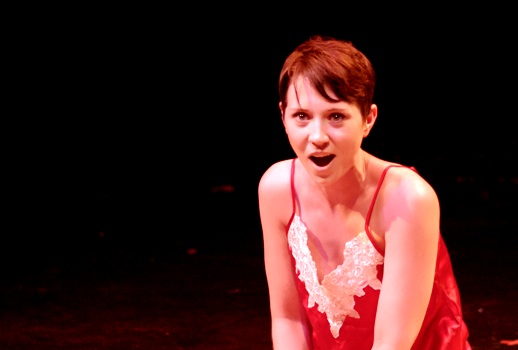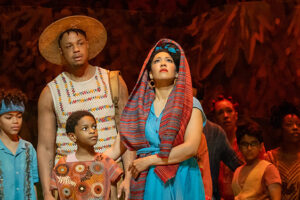

Despite its being ten years old, Dell’Arte had somehow escaped my notice until I heard about this Poppea. The organization’s admirable mission is to help young singers make the transition from the conservatory to full performing careers—rather like a self-contained Young Artists program where the singers perform leading roles rather than just covering and being in the chorus. Dell’Arte provides extensive language and musical coaching to supplement its long rehearsal process—a system which is clearly bearing fruit based on the mature and confident performances of the large Monteverdi cast.
Supporting these aims, Dell’Arte scored a canny coup for its first opera from the baroque repertoire by inviting the up-and-coming period-instrument ensemble The Sebastians to form the core of the Poppea band. Recent winner of the Audience Prize at the Early Music America Baroque Performance Competition, the Sebastians surely provided a salutary grounding for a crew of singers with little or no experience in this kind of music.
It was a tribute to Jeffrey Grossman, Sebastians harpsichordist and leader of the performance, that everyone sounded so at home in Monteverdi’s challenging signature style of heightened recitative, which was so ably supported by his intrepid continuo group of cellist Ezra Seltzer, harpist Christa Patton and tireless theorbist John Lenti.
Grossman’s work was strongly supported by the spare but inventive staging by Victoria Crutchfield which with no scenery to speak of and just a few props still vividly delineated the roiling world created in Busenello’s supreme libretto of a Roman court thrown into chaos by its emperor Nerone’s obsession with the seductive minx Poppea. That Nerone wishes to make her his empress is complicated both by his unhappy marriage to Ottavia (who is” infrigidita e infeconda”) and her long-suffering former lover Ottone. As the opera ends with an incoronazione (coronation), we know that Poppea–whose ambitions throughout are watched over by the god of love, Cupid–emerges victorious.
Costumes for the production were contemporary with touches of Roman swag, but modernity was not emphasized, other than by lines of cocaine done by Nerone and his crony Lucano and an obligatory cell phone appearance in the final scene, but Ottone still brought a dagger rather than a pistol to kill Poppea.

As Poppea, Greer Davis was a bewitching young seductress on the make, her light soprano warming up after a slightly uneasy beginning. Although they might not have always had the ideal blend for the numerous rapturous duets, their powerful erotic connection held the evening’s focus.
Their chief impediment, Katherine Howell’s Ottavia was more comfortable as the rejected wife mourning her fate than as the spiteful virago demanding Ottone kill her rival; her finely sustained farewell to Rome was one of the evening’s high points. As her advisor Hans Tashjian easily commanded the stage, not only because he was more than a head taller than anyone else. Seneca’s droning pronouncements often rub me the wrong way, but Tashjian’s astonishingly mature bass for once made them compelling and his commanded suicide proved genuinely moving.
Ottone, Poppea’s cast-off lover who becomes Ottavia’s hapless pawn, can sometimes come across as a sap but countertenor Jeffrey Mandelbaum movingly charted his fraught journey to eventual redemption. Although his voice eventually warmed up after a rocky start, it’s not an inviting sound. As the gullible but steadfast Drusilla, Rachel Barker’s appealing vocal and personal warmth made Ottone’s eventual capitulation to her devotion an inevitability.
Doubling Arnalta (often done by a tenor in drag) and Nutrice, Melissa Kelly cannily differentiated the rather similar roles of the two nurses, but too often she seemed underpowered, although Arnalta’s witty final solo of triumph revealed a more forthright (and welcome) comic verve and a punchier vocal style. Of the rest of the large cast, Noelle Arteche stood out for her sparky, street-wise Amore, and Kathleen Jasinskas’s Virtù and Valetto showed glimpses of a promisingly rich soprano.
Grossman’s spare but gratifyingly full musical edition (which added only a pair of violins to the continuo group) had relatively few cuts–one lost only a few minor gods: Pallade, Mercurio and Venere. I was surprised at the inclusion of two rarely heard scenes: a long monologue for Ottone before his confrontation with Ottavia which I believe is included in the recent Les Arts Florissants production, as well as an extended version of the scene between Poppea and Arnalta before Ottone’s entrance disguised as Drusilla. The latter conversation provides some interesting insights into their relationship, but it ends with Arnalta making a jolly exit rather than gradually falling asleep during her ravishing lullaby; I think I prefer the traditional version.

I took a friend to the performance had never before heard, much less seen a 17th century opera, and she was as consistently enthralled as I. The remarkable intimacy of Dell’Arte’s production was a boon—the singers and the musicians (not hidden in a pit) were so close that every musical and dramatic detail of each confrontation was absolutely immediate.
We felt ourselves returning to origins of opera as heightened speech—a goal which reached its most perfect embodiment in Poppea in 1643, the same year Monteverdi died; soon after, the primacy of showing off a singer’s virtuosity would begin to take over Italian opera. But here Monteverdi’s musical mastery makes the yards of recitative compulsively fascinating unlike in, for example, Landi’s 1631 Il Sant’Alessio. I remember squirming through the production of it brought to New York in 2007 by Les Arts Florissants—hoping in vain for a melody to appear, I thought it would never end.
Happily, five performances remain of this excellent Poppea, four with this first-night cast and a show on August 20 featuring instead a number of the covers performing the leading roles. This run presents an excellent and affordable opportunity to experience up-close one of opera’s greatest works. Just be warned: the show lasts nearly 3 and one-half hours.
And, please, Dell’Arte and the Sebastians: more 17th century works! I could imagine Cavalli’s La Calisto, for example, being a delightful choice for these young and enterprising artists.
In the meantime, Opera Omnia steps up to perform Monteverdi’s other late masterwork Il Ritorno d’Ulisse in Patria at the Baryshnikov Arts Center from September 10 to 12.
Photographs: Brian Long























Comments